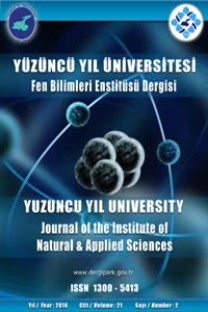Agelena orientalis (Araneae: Agelenidae: Ageleninae) Huni Ağ Örümceğinin Ağ Yapısı ve Örü Aygıtının Morfolojisi
Agelena orientalis, Ağ, Huni ağ örücü, Örü aygıtı, Örü memeleri, Spigot
The Web Structure and Morphology of the Funnel Web Spider of Agelena orientalis (Araneae: Agelenidae: Ageleninae)
Agelena orientalis, Funnel web spiders, Spigot, Spinneret, The spinning apparatus, Web,
___
- Foelix, R. (2011). Biology of Spiders. New York, USA: Oxford University Press.
- Hilbrant, M., & Damen, W. G. M. (2015). The embryonic origin of the ampullate silk glands of the spider Cupiennius salei. Arthropod Structure & Development, 44(3), 280-288. doi:10.1016/j.asd.2015.04.001
- Jocque, R., & Dippenaar-Schoeman, A. S. (2006). Spider Families of the World, (2nd Ed). Tervuren, Belgium: Royal Museum for Central Africa.
- Karschova, S., & Hajer, J. (2016). Spinnerets and silk-producing system of Segestria senoculata (Araneae, Araneomorphae, Segestriidae). Journal of Entomological and Acarological Research, 48(3), 388-394. doi:10.4081/jear.2016.5934
- Mariano-Martins, P., Lo-Man-Hung, N., & Torres, T. T. (2020). Evolution of spiders and silk spinning: Mini review of the morphology, evolution, and development of spiders’ spinnerets. Frontiers in Ecology and Evolution, 8, 109. doi:10.3389/fevo.2020.00109
- Opell, B. D., & Hendricks, M. L. (2009). The adhesive delivery system of viscous capture threads spun by orb-weaving spiders. Journal of Experimental Biology, 212(18), 3026-3034. doi:10.1242/jeb.030064
- Opell, B. D., & Hendricks, M. L. (2010). The role of granules within viscous capture threads of orb-weaving spiders. Journal of Experimental Biology, 213(2), 339-346. doi:10.1242/jeb.036947
- Pechmann, M., Khadjeh, S., Sprenger, F., & Prpic, N. M. (2010). Patterning mechanisms and morphological diversity of spider appendages and their importance for spider evolution. Arthropod Structure & Development, 39(6), 453-467. doi:10.1016/j.asd.2010.07.007
- Peters, H. M. (1987). Fine Structure and Function of Capture Threads. In W. Nentwig (Ed.), Ecophysiology of Spiders (pp. 187-202). Berlin, Germany: Springer, Berlin, Heidelberg. doi:10.1007/978-3-642-71552-5_13
- Shear, W. A. (1994). Untangling the evolution of the web. American Scientist, 82(3), 256-266.
- Sutherland, T. D., Young, J. H., Weisman, S., Hayashi, C. Y., & Merritt, D. J. (2010). Insect silk: One name, many materials. Annual Review of Entomology, 55, 171-188. doi:10.1146/annurev-ento-112408-085401
- Wang, Y. C., & Zhang, Z. S. (2018). Draconarius manus sp. nov., the third species of D. pseudocoreanus-group from China (Araneae: Agelenidae). Zootaxa, 4418(4), 397-400. doi:10.11646/zootaxa.4418.4.7
- World Spider Catalog. (2022). World spider catalog. Version 23.0. Natural History Museum Bern. http://wsc.nmbe.ch Erişim tarihi: 06.04.2022.
- ISSN: 1300-5413
- Yayın Aralığı: 3
- Başlangıç: 1995
- Yayıncı: Van Yüzüncü Yıl Üniversitesi Fen Bilimleri Enstitüsü
Aykut AYDIN, Nazmi POLAT, Semra SAYGIN, Melek ÖZPİÇAK, Savaş YILMAZ
Donmuş Çözünmüş Kanın Farklı Değerlerde Santrifüjünün DNA İzolasyonu Üzerine Etkileri
Cu2FeSnS4 Kalkojenit Filmlerin Optik ve Morfolojik Özellikleri
Canan AYTUĞ AVA, Şilan BATURAY
Yeşil Cevizlerden Ultrason Destekli Ekstraksiyon Yöntemiyle Fenolik Bileşiklerin Eldesi
Serdar UĞURLU, Emre BAKKALBAŞI
Kentsel Yeşil Alanların Planlamasında Kullanılan Konumsal Analiz Yöntemleri ve Kullanım Olanakları
Onur ŞATIR, Okan YELER, Serkan KEMEÇ
Güneş Enerjisi Kullanılarak Bir Villanın Elektrik İhtiyacının Karşılanması
Melike YALILI KILIÇ, Sümeyye ADALI
Bizmut Tabanlı Bazı Alaşımların Radyasyon Zırhlama Kapasitelerinin İncelenmesi
Meryem YILMAZ, İlhami ERKOYUNCU, Hatice Gürel ÖZDEMİR, İskender DEMİRKOL, Mustafa Recep KAÇAL, Ferdi AKMAN
Akkaraman Koyun Irkında Callipyge Gen Polimorfizmin Araştırılması
